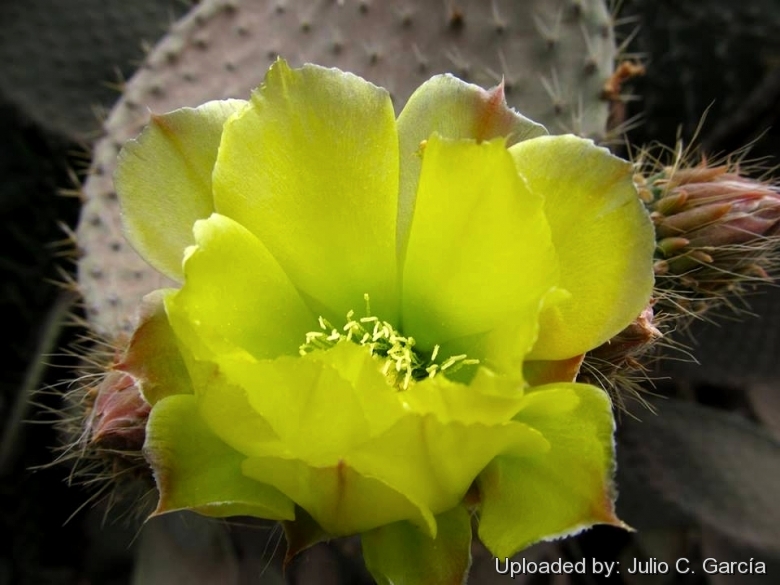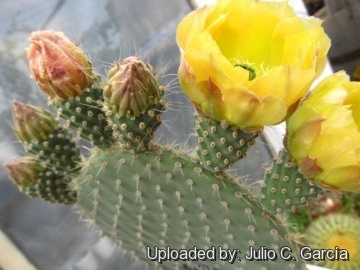




Your support is critical to our success.

Origin and Habitat: Opuntia leucotrichaSN|9736]]SN|9736]] is a widely distributed species across the Altiplano of central Mexico, where it occurs in the states of Aguascalientes, Guanajuato, Hidalgo, Jalisco, Nuevo León, Querétaro, San Luis Potosí, Tamaulipas and Zacatecas. It is used and cultivated in Mexico and in the Mediterranean as forage for animals and as food for humans and often sub-spontaneous after cultivation. The plant is an invasive species in Florida.
Altitude range: Between 1500 and 2500 metres above sea level.
Habitat and Ecology: This cactus occurs in xerophyllous scrub and matorral with an annual rainfall ranging from 220 to 450 mm/annum. It form large shrubs and maintains a good population of perennial grasses under its canopy. This species is widespread and relatively abundant though with irregular distribution and variable density. There are no major threats to this species, but some of the wild populations have been affected by the continuous increase in the cultivated area of maize and dry beans.
Synonyms:
- Opuntia leucotricha DC.
- Consolea leucacantha Lem.
Opuntia leucotricha DC.
Mém. Mus. Hist. Nat. 17: 119. 1828.
Synonymy: 5
- Opuntia leucotricha DC.
- Consolea leucacantha Lem.
- Opuntia leucacantha Salm-Dyck
- Opuntia leucotricha var. fulvispina F.A.C.Weber in K.Schum.
- Opuntia fulvispina Salm-Dyck in Pfeiff.
ENGLISH: Aaron's Beard Prickly Pear, Arborescent Pricklypear, Semaphore cactus
SPANISH (Español): Durazillo Blanco, Duraznillo, Durasnilla, Nopal duraznillo, Duraznillo colorado, Duraznillo blanco, Nopal blanco, Nopal colorado
SWEDISH (Svenska): Raggopuntia
Description: Opuntia leucotrichaSN|9736]]SN|9736]] (Duraznillo) is a jointed shrubby cactus forming clumps or small trees with distinct trunks and a large top often 3 to 5 meters high. Flowers are deep yellow with white stamens and deep red stigma with green lobes. Fruit is fragrant whitish-yellow ( Duraznillo blanco) or red ( Duraznillo colorado), have a good taste and can be found in Mexican markets.
Stems: Trunk as well as the older joints covered with long white bristles. Cladodes (joints) oblong to orbicular, 10 to 25(-30) cm long and to 12 across, pubescent. In particular, the newly developing cladodes of Opuntia leucotrichaSN|9736]]SN|9736]] tended to become flattened in a direction perpendicular to a light beam, thereby intercepting more of the light compared with a random orientation of the cladodes.
Areoles: Numerous, closely set, small, to 1 cm apart. the upper part filled with yellow glochids, the lower part at first with only 1 to 3 flexible white spines, one much longer, to 3 cm.
Flowers: Yellow, 4 to 5 cm. long (including ovary), 4-8 cm in diameter. Petals yellow, broad. Pericarpel with numerous areoles, the upper ones bearing long, bristly glochids (ca. 1 cm. long). Style red, stigma-lobes green.
Fruit: Variable, globose, 4 to 6 cm long, white or purple, the rind not easily coming off from the pulp, aromatic, edible.
Bibliography: Major references and further lectures
1) Gómez-Hinostrosa, C., Sánchez , E., Guadalupe Martínez, J. & Bárcenas Luna, R. 2013. Opuntia leucotricha. The IUCN Red List of Threatened Species. Version 2014.2. <www.iucnredlist.org>. Downloaded on 13 August 2014.
2) Candelario Mondragón-Jacobo, Salvador Pérez-González “Cactus (Opuntia Spp.) as Forage” Food & Agriculture Org., 2001
3) Peter Hanelt, Institute of Plant Genetics and Crop Plant Research, W. Kilian “Mansfeld's Encyclopedia of Agricultural and Horticultural Crops: (Except Ornamentals)” Springer Science & Business Media, 10/Apr/2001
4) Park S. Nobel “Cacti: Biology and Uses” University of California Press, 2002
5) Park S. Nobel “Environmental Biology of Agaves and Cacti” Cambridge University Press, 16/Oct/2003
6) Brighton & Rose "The Cactaceae" Vol I, page 108 1919 [21 Jun 1919]
7) David Hunt, Nigel Taylor “The New Cactus Lexicon” DH Books, 2006
8) Edward F. Anderson “The Cactus Family” Timber Press, 2001
9) Marian Van Atta “Exotic Foods: A Kitchen and Garden Guide” Pineapple Press Inc, 2002
10) C. M. McKell, James Pershing Blaisdell, Joe R. Goodin “Wildland shrubs -- their biology and utilization” Intermountain Forest and Range Experiment Station, U.S. Dept. of Agriculture, 1972
11) Wikipedia contributors. "Opuntia leucotricha." Wikipedia, The Free Encyclopedia. Wikipedia, The Free Encyclopedia, 14 Mar. 2014. Web. 13 Aug. 2014
12) Allorge-Boiteau, L. “Les cactées introduites à Madagascar.” Succulentes (France) 25(1): 9–16.2002.
13) Anonymous. 1986. "List-Based Rec.", Soil Conserv. Serv., U.S.D.A. Database of the U.S.D.A., Beltsville.
14) CONABIO. 2009. "atálogo taxonómico de especies de México." 1. In Capital Nat. México. CONABIO, Mexico City.
15) Small, J. K. 1933. "Man. S.E. Fl." i–xxii, 1–1554. Published by the Author, New York.
16) Wunderlin, R. P. 1998. "Guide Vasc. Pl. Florida" i–x, 1–806. University Press of Florida, Gainseville.

Opuntia leucotricha Photo by: Julio C. García

Opuntia leucotricha Photo by: Julio C. García
Cultivation and Propagation: Opuntia leucotrichaSN|9736]]SN|9736]] is a hardy cactus easily found in cultivation. It is a summer grower species that offers no cultivation difficulties.
Soil: Use a very a particularly draining substratum, as it is sensitive to rottenness when in presence of humidity and low temperatures and let the soil dry out between waterings, since it's natural habitat is in sandy or gravelly, well draining soils.
Repotting: Repot in the spring, when their roots become cramped. Generally, they should be repotted every other year in order to provide fresh soil. After repotting, do not water for a week or more.
Water: In summer, during the vegetative period, it must be regularly watered, but allowing the substratum to completely dry up before irrigating again (but do not overwater ); in winter, it’s to be kept dry. Preferable not to water on overcast days, humid days or cold winter days.
Hardiness: It is a quite frost resistant cactus, hardy to -7° C or less if very dry). However in cultivation it is better not to expose it to temperatures lower than -0° C, even if in an aerated and protected location, in order to avoid the formation of anti-aesthetic spots on the epidermis. In presence of high atmospheric humidity avoid any frost as it is particularly sensitive to root rot. USDA Zone 7-10. It can handle extremely high temperatures in summer.
Exposure: Outside full sun or afternoon shade, inside needs bright light, and some direct sun.
Use: It is suitable for “desert” gardens, in association with other xerophytes. Where the open air cultivation is not possible due to the climate, it is to be cultivated in pot in order to shelter it in winter.
Propagation: Stem division. Prickly pear pads root easily and grow rapidly when placed in loose, well-draining soil.
| Your Actions | |
|---|---|
| Back to Opuntia index | |
| Back to Cactaceae index | |
 |
Back to Cacti Encyclopedia index |
Privacy stantement - Terms and conditions - How to cite - About us - Feedback - Donate



